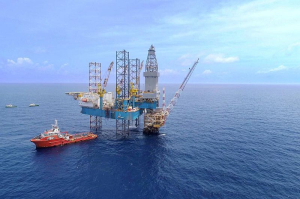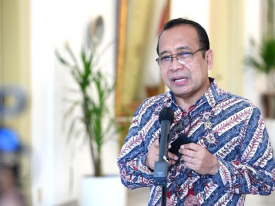Central Bangka develops Kulong Biru tourism site
Central Bangka regency is developing Kulong Biru, or more popularly known as Kaolin Lake, which was originally an abandoned tin ore mining. The tourism site is located in Koba district, Central Bangka regency, Bangka Belitung province. The project began in 2021 and worth IDR9.59 billion.
Central Bangka as a regency was established in 2003. It directly borders Pangkalpinang city, Bangka and South Bangka regencies. Central Bangka has a size of 2,269.03 square kilometers (sqm) with a population of 192,429. The citizens are mostly Muslim with a percentage of 86.99%.
The Investment Coordinating Board (BKPM), which works together with Central Bangka regency in developing Kulong Biru, is a government agency in charge of implementing policy and service coordination in investment. The agency was founded in 1973 and has been led by Investment Minister Bahlil Lahadalia since 2021.
Kulong Biru tourism site
The regency has aimed to establish Kulong Biru as a tourism site. The site will be developed into an eco-tourism, edu-tourism and sport-tourism area. The concept is based on enjoying the beautiful two-colored lake while tasting local cuisine with cultural aspects. The site will need playgrounds, gazebos and an art gallery with the green concept, furthermore adding public facilities such as toilets and musholla (praying room).
Kaolin Lake is a man-made lake created from extensive mineral mining that was abandoned by miners. The minerals, such as kaolin (which is ingredients for pharmaceutical and cosmetic products) and tin, merged with underground water and also rainwater. The blue or green color is the result of scattering sunlight that hits the lake surface that consists of heavy metals. There are a lot of similar sites in Bangka Belitung as the province is known for extensive mining.
Kulong Biru has become a magnet for tourists for its beautiful bright blue color water. Since 2021, there has been few facilities such as fences, bridges and small boats for tourists who want to take a closer look at the lake. Meanwhile, the surroundings of the lake consist of hills as the result of the mining.
Eksa, a local tour guide from Jendela Wisata, explained to Kompas.com on September 11, 2019, "The shape of kaolin itself is like clay, only white in color."
The lake is roughly 60 kilometers from Depati Amir Airport and 15kms from the capital of Central Bangka, Koba. It takes 60 minutes from Pangkalpinang to reach the lake by cars. The accessibility to the lake is already better, giving the chance for many tourists to come there anytime.
On the other hand, according to Eksa, there are some benefits from kaolin such as beauty raw materials or skincare, stomach medicine, diarrhea medicine and building raw materials such as Chinese ceramics.
Challenges to developing Kaolin Lake
The kaolin mineral is actually dangerous to humans. Eksa said tourists were not allowed to swim as the lake contains harmful chemicals or poison. There were signs banning swimming for tourists around the lake and its surroundings. Unfortunately, many people disobey the rules while there were no lifeguards or security to enforce the regulations.
“We [the lake management] don't recommend swimming since it is potentially poisonous, but still some people swim despite the no-swimming signs. It is beyond [our] responsibility if someone violates it," said Eksa.
Already have an account? Sign In
-
Start reading
Freemium
-
Monthly Subscription
30% OFF$26.03
$37.19/MonthCancel anytime
This offer is open to all new subscribers!
Subscribe now -
Yearly Subscription
33% OFF$228.13
$340.5/YearCancel anytime
This offer is open to all new subscribers!
Subscribe now






